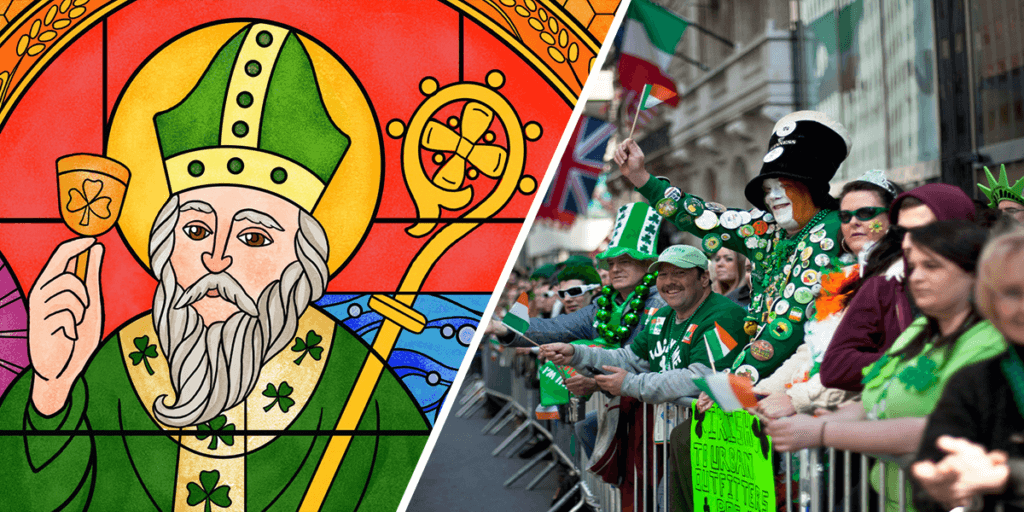The History & Celebration of St. Patrick’s Day
March 15, 2019
 Top of the mornin’ to you! With St. Patrick’s day right around the corner, let’ s take a look at the history of this beloved holiday!
Top of the mornin’ to you! With St. Patrick’s day right around the corner, let’ s take a look at the history of this beloved holiday!
St. Patrick’s Day is celebrated annually on March 17. The Irish have observed this day as a religious holiday for over 1,000 years. On St. Patrick’s Day, Irish families would traditionally attend church in the morning and celebrate in the afternoon.
Who Was St. Patrick?
Saint Patrick, who lived during the fifth century, is the patron saint and national apostle of Ireland. Born in Roman Britain, he was kidnapped and brought to Ireland as a slave at the age of 16. He later escaped, but returned to Ireland and was credited with bringing Christianity to its people.
In the centuries following Patrick’s death (believed to have been on March 17, 461), the mythology surrounding his life became ever more ingrained in the Irish culture.
St. Patrick’s Day Celebrations
More than 100 St. Patrick’s Day parades are held across the United States; New York City and Boston are home to the largest celebrations.
The first parade held to honor St. Patrick’s Day took place not in Ireland but in the United States. On March 17, 1762, Irish soldiers serving in the English military marched through New York City. Along with their music, the parade helped the soldiers reconnect with their Irish roots, as well as with fellow Irishmen serving in the English army.
Over the next 35 years, Irish patriotism among American immigrants flourished. Groups would hold annual parades featuring bagpipes and drums.
In 1848, several New York Irish Aid societies decided to unite their parades to form one official New York City St. Patrick’s Day Parade. Today, that parade is the world ‘s oldest civilian parade and the largest in the United States, with over 150,000 participants. Each year, nearly 3 million people line the 1.5-mile parade route to watch the procession, which takes more than five hours.
The Irish in America
When the Great Potato Famine hit Ireland in 1845, close to 1 million poor and uneducated Irish Catholics began pouring into America to escape starvation.
Despised for their alien religious beliefs and unfamiliar accents by the American Protestant majority, the immigrants had trouble finding even menial jobs. When Irish Americans in the country’s cities took to the streets on St. Patrick’s Day to celebrate their heritage, newspapers portrayed them in cartoons as violent.
The American Irish soon began to realize, however, that their large and growing numbers endowed them with a political power that had yet to be exploited. They started to organize, and their voting block, known as the “green machine,” became an important swing vote for political hopefuls. Suddenly, annual St. Patrick’s Day parades became a show of strength for Irish Americans.
St. Patrick’s Day Celebrations Around the World
Today, people of all backgrounds celebrate St. Patrick’s Day, especially throughout the United States, Canada and Australia. Although North America is home to the largest productions, St. Patrick’s Day is celebrated in many other locations far from Ireland, including Japan, Singapore and Russia.
In modern-day Ireland, St. Patrick’s Day was traditionally a religious occasion. In fact, up until the 1970s, Irish laws mandated that pubs be closed on March 17. Beginning in 1995, however, the Irish government began a national campaign to use interest in St. Patrick’s Day to drive tourism and showcase Ireland and Irish culture to the rest of the world. Approximately 1 million people annually take part in Ireland ‘s St. Patrick’s Festival in Dublin, a multi-day celebration featuring parades, concerts, outdoor theater productions and fireworks shows.
*Content sourced by: History.com Editors. “History of St. Patrick’s Day.” HISTORY, A&E Television Networks, 27 Oct. 2009, www.history.com/topics/st-patricks-day/history-of-st-patricks-day
